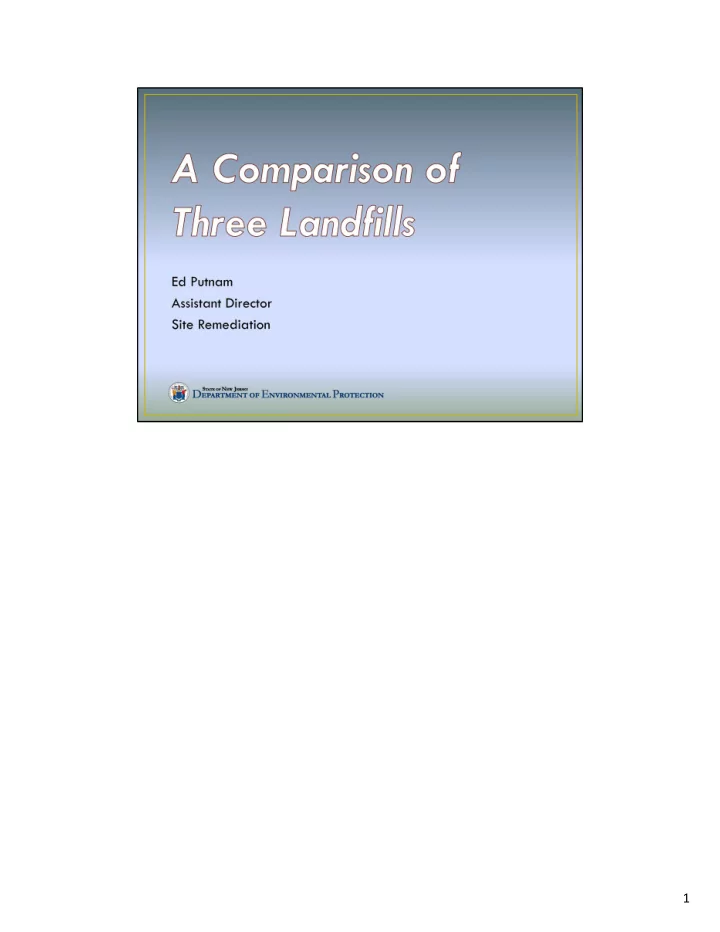

1
Pepe Field was a 3.5 acre landfill in Boonton, NJ. • In mid ‐ 60’s the town purchased the site and covered it with soil to enable construction • of a recreational facility on top. In 1969 the town implemented an odor abatement plan to try to control strong H2S • odors. Original remedy (signed in 1989 under State lead) included maintaining cover; installing • gas collection and treatment system, improvement of the leachate and collection system; and monitoring of ground water. The estimated cost of this remedy was about $1.3 million. In late 1991 the State requested EPA take lead. Additional investigations indicated that • the selected remedy would require several modifications to achieve the remedial goals set forth in the ROD. The reasons cited for the change included: it was found that wastes extended beyond the boundaries of the site; it was determined that the existing leachate collection trench would need to be completely reconstructed; extraction; additional gas and leachate treatment not anticipated in the remedy would be needed; and the cap would have to be redesigned. The migration of methane gas generated at Pepe Field to adjacent homes was identified • as a potential threat. 2
3.5 acre site used as a landfill from 1920’s until 1950; primarily for disposal of processing • waste from manufacture of edible oils, cleaning and soap products. Pepe Field in the middle of residential neighborhood . Samples containing more than 60% Methane were obtained below the ball field. Levels • of methane >100% of the LEL were found off the site near a house. The accumulation of the methane generated at Pepe Field was identified as a potential threat to public safety. The final cost was approximately $16 million. • Starting in October 1998 waste removal began from Pepe Field and eight adjacent • properties. Approximately 35,000 to 60,000 cubic yards of material were excavated. The waste material was stabilized using cement kiln dust to reduce the emission of H2S so that it could be safely excavated and transported off ‐ site for disposal. In addition, during construction work waste was found under two adjacent homes. Waste removal on those properties was completed in mid ‐ 2000. A total of approximately 85,000 tons of material was shipped off site for disposal. 3
Depiction of the final capped Saufley landfill. • 4
Florida permitted this C&D debris landfill beginning in 1990. After the 2004 and 2005 • hurricanes the Saufley Field Landfill accepted large volumes of construction and demolition debris including large amounts of water ‐ damaged drywall. Poor management practices (i.e. lack of covering wastes) may have led to excess gas production. ATSDR measured levels of H2S up to 224 ppb in one home in November 2006. • The county evaluated options. The cost of full excavation was estimated at between • $20 ‐ 30 million. In December 2011 Escambia County approved a $5.9 million bid for the work on the • landfill. Work included reducing the height of the landfill from a roughly 130’ mound to a flat sloping surface ranging from 112’ ‐ 126’. The material that was excavated was more recently deposited materials and was mostly dirt and no significant amount of drywall which is the source materials for H2S generation. Excavated material (approximately 220,000 cubic yards) was sent to county owned Perdido Landfill. Since the waste was moved to another county landfill there was no disposal fee. Once the material was removed the remaining landfill was leveled, allowing for • installation of a soil/geomembrane/synthetic grass cap and improvements to the surface water and landfill gas collection systems. 5
In this figure from Escambia County, you can see a cross section showing the limited • area on the top of the landfill that was excavated. Note that what remained was capped. County officials reported that no significant amount of drywall in the material was • removed. 6
H2S was measured in well #1 at 250,000 ppm in mid 2013, to our knowledge one of the • highest levels of H2S at any landfill site. According to SEP records over 375,000 cubic yards of material were brought in to the • site between December 2011 and June 2013. More than 50 percent was construction and demolition screenings (CDS) and 60 percent • of the screenings arrived prior to Sandy. 7
8
Almost 200,000 yards of sulfur containing drywall are in the SEP material at Fenimore. • Saufley excavated material essentially has no drywall or H2S generating material. • Excavation and disposal of material (various types of vegetable oils) at Pepe Field cost • $16 million or $4 million per acre. 9
Recommend
More recommend